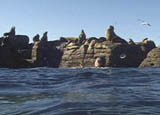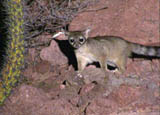| Baja, CA: In search of the grey whale | |
|
|
 |
I love the water, but navigating a kayak can be kind of tricky. This week I used a kayak to get up close to some special animals: the California sea lions. |
| These massive mammals belong to a group called "pinnapeds." They're known for their lion-like roar and tight, fur-like mane. The sea lions have an outer ear flap and, unlike seals' flippers, their flippers turn out. | |
| Did I say they were big? They're gigantic, with males reaching 800 pounds! The females have only one pup, so they fiercely protect their young on a rocky home called a "rookery." |  |
| When I got close to the rookery, I saw why the males fight for space: there's not much room. Except for the tight space, this is great spot, close to lots of shrimp and fish.
Behind the Scenes: I don't think anyone has ever gone swimming with the sea lions like I did for this show. I was more than a bit nervous. Big males protected harems of females, and they didn't seem to happy to see me. One bull turned on me, opened its mouth, and showed all its nasty-looking teeth. And where am I? My GPS (Global Positioning System) says that I'm in the Sea of Cortez, 700 miles south of the Mexican border, off the coast of Baja, California. I'm here to find a really big Feature Creature: the gray whale. Before I do that, there are plenty of things to see. When I paddled into shore I saw a lightfoot crab in one of the tidal pools. These crabs graze on algae using their front pincers. Diving in the water, I plunged into a school of anchovies, and even found a squid. |
|
 |
To really explore the water, I suit up in scuba gear. Did you know that you can be certified to dive when you're twelve? You can see some amazing things underwater, like over 1,000 species of tropical fish! |
| I spotted a porcupine fish and some colorful angelfish. You know, it's funny about angelfish. Scientists don't know why these fish are so colorful. Is it helpful to them, or just the random result of biodiversity? | |
| To find the gray whale, I had to leave the water and cross the Baja Peninsula in an ATV -- an amphibious craft that travels on sea and land. I headed west across the desert to the Pacific Ocean. Here I spotted a dead, desiccated turtle. |  |
| What happened to the turtle? There's no way to know.
The desert may look dead, but it's actually filled with life. Of 120 known species of cactus, 75 percent can be found on the Baja Peninsula. One cactus, the cardone, stores the scant water that falls here. Water runs down the ribs of the cactus. In fact, the cardone is 80 percent water. |
|
 |
Then there's the prickly pear, which -- believe it or not -- I sliced up and cooked for dinner. It tasted like a mix between an eggplant and string beans (though it certainly wasn't the best wild dinner I ever had). |
| The desert is alive with critters too. I found a desert sand iguana under a rock. If it's caught by its tail, the tail just pops off, and it grows a new one!
A rattler waited under a bush. That's one desert critter you give plenty of room! |
|
| Night in the desert is especially active. I put on a headlamp and prowled around. I saw a ringtail cat, which is actually closer to a raccoon than a cat. |  |
| The ringtail blocks its den with debris to keep predators out. Its stinky smell is good protection, too!
I finally spotted some pickle-weed, a clue that I was close to the ocean -- and our Feature Creature. Pickleweed grows in the salty ground near the sea. The small bladders, or "pickles," store water. It's fun to squeeze the bubbles and see water squirt out. |
|
 |
When I reached the San Ignacio Lagoon, I met Luis, a master mariner, who knows where the gray whales hang out. |
| Luis took me next to a deserted island, where I got a look at "los pelicanos," or pelicans, and an osprey, an ocean raptor or bird of prey. Ospreys take one mate for their entire life.
Next, Luis took me to the mouth of San Ignacio Lagoon. We immediately spotted some gray whales. The whales came so close to our boat that I thought that they might tip us over. When a whale went underwater, I saw its "footprint," the swirl of water on the surface that signals that a big whale is below.
|
|
| The whales migrate from Alaska to San Ignacio lagoon each year, where they mate and give birth to calves. In April they head back to the Bering Sea. When we saw a mother and a calf, the mother came close enough for me to feel the barnacles that cover her skin. |  |
I was so excited I could hardly speak! What made this moment especially cool was that once, the gray whales were nearly hunted to extinction.
Totally Wild, |
|